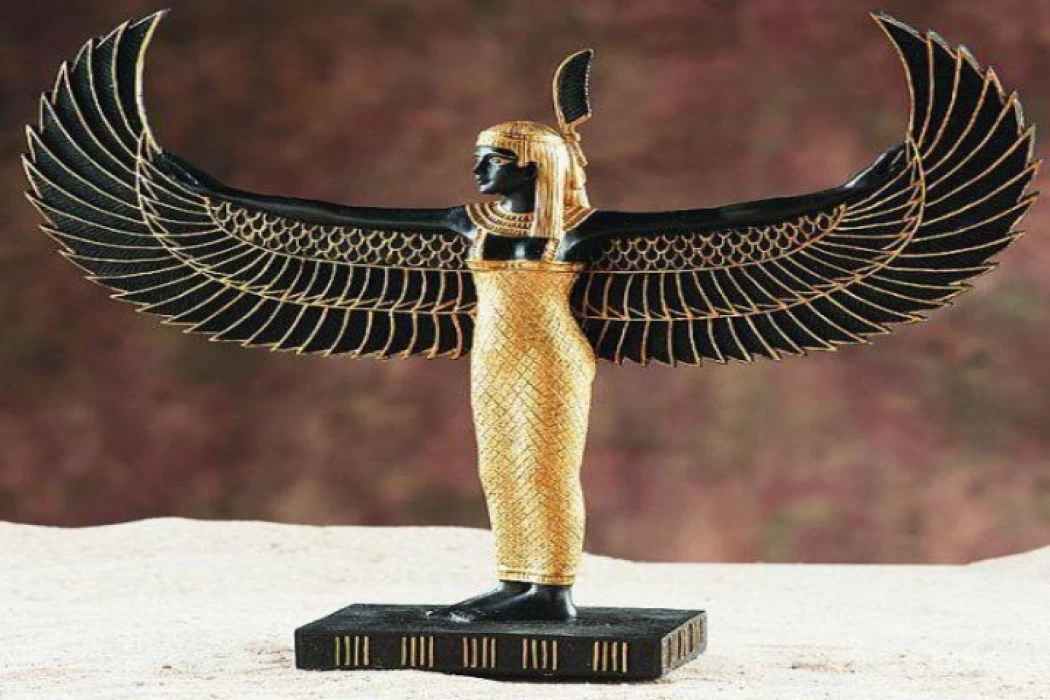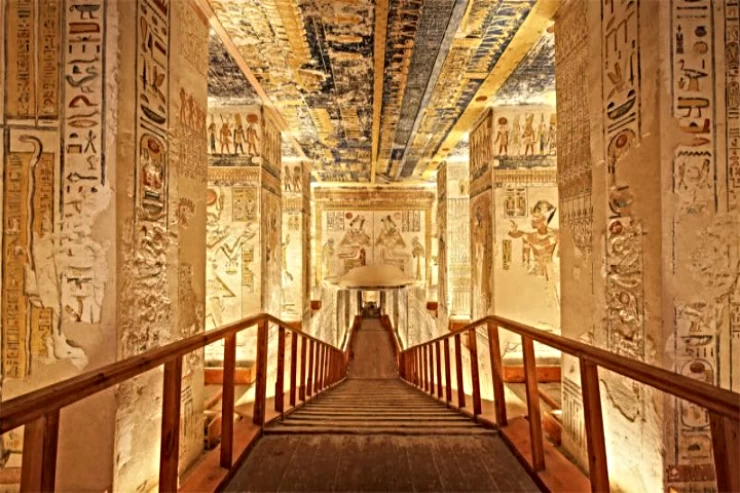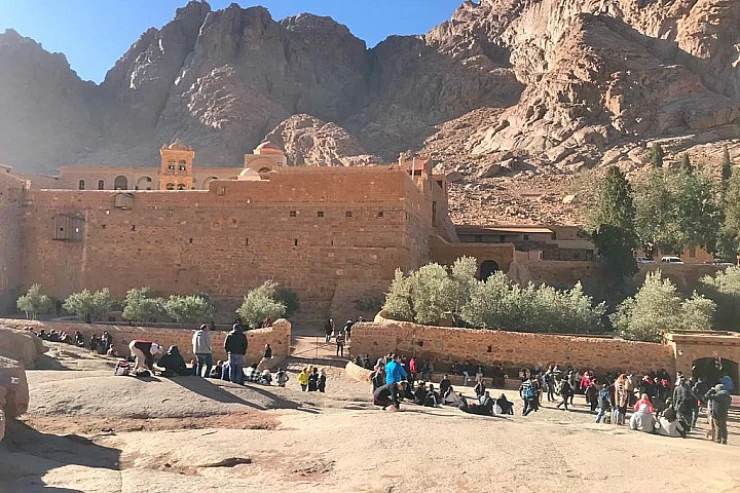
Ma`at Goddess no Egipto Antigo
Ma`at Goddess no Egipto Antigo
Deusa Ma`at segundo a antiga religião egípcia é uma deusa da verdade e da justiça, Ma`at é filha de Re deus e esposa de Thout deus do conhecimento Ma`at deusa representada em forma de mulher com pena de avestruz acima da cabeça e segurando a Ankh que significa a chave da vida e a outra mão segurando a mace
No submundo dos antigos egípcios, o coração dos mortos era colocado na balança de um lado e a pena da deusa Maat do outro lado. Se o coração do defunto se inclinasse, ele entraria no Paraíso nas suas crenças, mas se a pena inchasse, ele entraria no Inferno, que era representado pelas antigas crenças egípcias sob a forma de um monstro predador imaginário chamado Amamut, cuja cabeça é a cabeça de um crocodilo e o seu corpo é o corpo de um leão e as suas costas são o corpo de um hipopótamo. O tribunal no submundo era composto por 42 juízes, o número de regiões do Egipto, encabeçadas por Osíris.
A concepção dos antigos egípcios no Dia do Julgamento era que Anubis acompanharia os mortos à sala do tribunal, e os juízes começariam a questionar o falecido sobre as suas acções neste mundo, e se ele estava a seguir o Maat (o caminho certo) ou se estava entre os pecadores. E o falecido começa a defender-se e diz: Eu não matei ninguém, não expus uma pessoa, e não reclamei de um trabalhador com o seu patrão, e não roubei. E eu alimentava os pobres, e davam-me roupa aos nus, e ajudava as pessoas, e costumava dar água aos sedentos. Então os juízes começaram a perguntar-lhe sobre o seu conhecimento dos deuses, e ele teve de mencionar os deuses pelos seus nomes e ter cuidado para não se esquecer de um deles.
A oferta (Maat) é um dos mais importantes e mais importantes tipos de ofertas que os reis faziam questão de retratar nos templos, devido ao seu significado e grande importância. O sacrifício de "Maat" confirma a missão do rei de alcançar a ordem (Maat) na terra e de satisfazer os deuses. [4]
O conceito de "Maat" era o sistema padrão exacto para tudo, que representa a base do mundo, e tudo o que corresponde aos propósitos da divindade Criadora. Assim, é imperativo que os seres humanos os preservem e aprovem, e que restaurem o "Maat" e o sistema ao seu estado adequado se este for exposto a qualquer defeito ou desordem. E uma vez que a visão egípcia do "Maat" como o elemento essencial e material sobre o qual vive todo o mundo, e como um poder para os deuses e para os vivos e os mortos entre os humanos, os "Coffins Texts" mencionaram que os deuses vivem (Maat), e os deuses aprovaram o "Maat" na terra, e a sua aprovação foi em A terra é da responsabilidade do rei, que representa os deuses entre os homens, e vive como ele em (Maat).
A oferta de "Maat" resume de forma fortemente simbólica tudo o que se entende por adoração e sacrifícios oferecidos aos deuses, e todos os rituais do serviço diário nos templos, e as ofertas oferecidas. Portanto, um templo egípcio quase não é desprovido da cena do sacrifício do "Maat" nas várias inscrições, cenas religiosas, e cenas da oferenda e rituais.
Era necessário que o rei reconhecesse o "Maat" na terra, e isto foi encarnado na apresentação pelo rei da oferenda do "Maat" aos deuses como metáfora para estabelecer a ordem e a justiça, e o que quer que os deuses quisessem. O rei costumava apresentá-lo diariamente aos deuses como prova tangível de ser para eles um representante no seu gabinete divino no quadro de (Maat).
O "sacrifício de maat" indica que a missão do rei é conseguir o "maat", o que significa que o sacrifício aqui é uma metáfora ou uma expressão simbólica para completar a tarefa pela qual o rei é responsável. Embora muitos textos indiquem que tanto os deuses como o rei reanimam o "Maat" no sentido moral mais do que no sentido sacrifical e que a divindade e o rei apenas se alimentam do "Maat" como a verdade que é dita, e a justiça que é estabelecida.
O sacrifício do "Maat" apareceu no Reino do Meio, embora não tenha aparecido depois disso até ao reinado do rei Tutmés III. A cena (a oferenda do "Maat") foi gravada nas inscrições das paredes da maioria dos templos egípcios, e nela o rei é mostrado de pé diante da divindade e apresentado a ele o símbolo do "Maat" na sua mão, ou num recipiente. E o sacrifício de "Maat" terá a forma de uma pequena estátua da deusa "Maat", a deusa da verdade, da justiça, e da apertada ordem cósmica sentada com uma pena de "Maat" na sua cabeça, e na sua mão está o sinal da vida. Em casos raros, encontramos a apresentação da pena de "Maat" apenas, e que foi no templo de "Seboua" ao rei "Ramsés, o Segundo".
Entre os templos em que surgiu a cena do sacrifício do "Maat": o templo "Amun-Ra" em Karnak (em várias cenas do reinado do rei "Thutmose III", em frente de várias divindades); e o templo "Aton" em "Karnak"; e o templo de "Seti o Primeiro" em Abydos, e o templo de "Luxor". Normalmente, a inscrição é acompanhada pela forma de oferta, que inclui a frase: "Hnk mAat n nb MAat" (oferecer Maat ao Senhor do Maat). Normalmente, o (sacrifício Maat) era apresentado aos deuses masculinos e não às fêmeas. E na vanguarda dos deuses que eram representados recebendo o sacrifício: (Amun; Amun-Ra; Hor-Akhati; Amun-Ra Ka-Mutaf; Amun Min; Ra-Hor Akhti; Ptah; Khonsu; Shu; Ozir; Set; Atum; Montu; Khnum; Sobek; Hathor, Iza, Min).
Ma`at Goddess in Ancient Egypt
Goddess Ma`at according to ancient Egyptian religion is a goddess of truth and justice, Ma`at is the daughter of Re god and wife to Thout god of knowledge Ma`at goddess represented in women form with ostrich feather above her head and holding the Ankh which means the life key and the other hand holding the mace
In the underworld of the ancient Egyptians, the heart of the dead were placed on the scales on one side and the feather of the goddess Maat on the other side. If the deceased’s heart tilted, he would enter Paradise in their beliefs, but if the feather swelled, he would enter Hell, which was represented by ancient Egyptian beliefs in the form of an imaginary predatory monster named Amamut, whose head is the head of a crocodile and his body is the body of a lion and its back is the body of a hippo. The court in the underworld consisted of 42 judges, the number of regions of Egypt, headed by Osiris.
The 42 Laws of Maat: Ancient Egyptian Society's Ethical Underpinnings The fundamental tenets of justice and morality in ancient Egypt were established by the 42 Laws of Maat.
The conception of the ancient Egyptians on Judgment Day was that Anubis would accompany the dead to the courtroom, and judges would begin to question the deceased about his actions in this world, and whether he was following the Maat (the right path) or was he among the sinners. And the deceased begins to defend himself and says: I did not kill anyone, I did not expose a person, and I did not complain about a worker with his boss, and I did not steal. I was feeding the poor, and I was given clothes to the naked, and I helped people, and I used to give the thirsty water. Then the judges began to ask him about his knowledge of the gods, so he had to mention the gods by their names and beware of forgetting one of them.
To the pharaohs, Ma'at was represented as a goddess with an ostrich feather on her head, a symbol of justice. The goddess held the key of life, Menkh, in one hand and a scepter in the other, symbolizing balance. She was credited with controlling the seasons and the movements of the planets and stars.
The Cult of Maat
While the cult of Maat was more than limited, the respect she commanded was, however, boundless. For maat (justice) was always a cornerstone of social balance. Respect among humankind, in particular, ensured a measure of salvation. A salvation that Maat would appreciate during the final judgment rendered by Osiris. "To speak according to Maat" meant to speak the truth. At the Last Judgment, the heart spoke according to Maat and could not lie. Upon death, no deceased could avoid the trial of the Last Judgment.
There, the weight of good and evil accumulated in each person's heart was calculated. Thus, the deceased who had lived with justice and kindness would be assured of having their heart compared to Maat, to their advantage. It was during psychostasis (the "weighing of the soul") that everything concerning their future in the afterlife was decided. Maat as a principle was created to meet the complex needs of the emerging Egyptian state, which embraced diverse peoples with conflicting interests. The development of such rules sought to avoid chaos, and Maat became the basis of Egyptian legislation.
The concept of "Maat" was the exact standard system for everything, which represents the basis of the world, and everything that corresponds to the purposes of the Creator deity. Hence, it is imperative for humans to preserve and approve them, and to restore "Maat" and the system to its proper condition if it is exposed to any defect or disorder.
And since the Egyptian view of the maat as the essence and material element upon which the whole world lives, and as a power for gods and for the living and the dead among humans, the "Coffins Texts" mentioned that gods live on (Maat), and the gods approved "Maat" on earth, and its approval was on The land is the responsibility of the king, who represents the gods among men, and lives like it on (Maat).
















